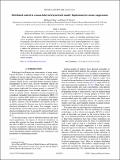Distributed control in a mean-field cortical network model: Implications for seizure suppression
Author(s)
Ching, ShiNung; Brown, Emery N.; Kramer, Mark A.
DownloadChing-2012-Distributed control in a mean-field cortical network model.pdf (1.338Mb)
PUBLISHER_POLICY
Publisher Policy
Article is made available in accordance with the publisher's policy and may be subject to US copyright law. Please refer to the publisher's site for terms of use.
Terms of use
Metadata
Show full item recordAbstract
Brain electrical stimulation (BES) has long been suggested as a means of controlling pathological brain activity. In epilepsy, control of a spatially localized source, the seizure focus, may normalize neuronal dynamics. Consequently, most BES research has been directed at controlling small, local, neuronal populations. At a higher level, pathological seizure activity can be viewed as a network event that may begin without a clear spatial focus or in multiple sites and spread rapidly through a distributed cortical network. In this paper, we begin to address the implications of local control in a network scenario. To do so, we explore the efficacy of local BES when deployed over a larger-scale neuronal network, for instance, using a grid of stimulating electrodes on the cortex. By introducing a mean-field model of neuronal interactions we are able to identify limitations in network controllability based on physiological constraints that suggest the need for more nuanced network control strategies.
Date issued
2012-08Department
Harvard University--MIT Division of Health Sciences and Technology; Massachusetts Institute of Technology. Department of Brain and Cognitive SciencesJournal
Physical Review E
Publisher
American Physical Society
Citation
Ching, ShiNung, Emery Brown, and Mark Kramer. “Distributed Control in a Mean-field Cortical Network Model: Implications for Seizure Suppression.” Physical Review E 86.2 (2012). ©2012 American Physical Society
Version: Final published version
ISSN
1539-3755
1550-2376